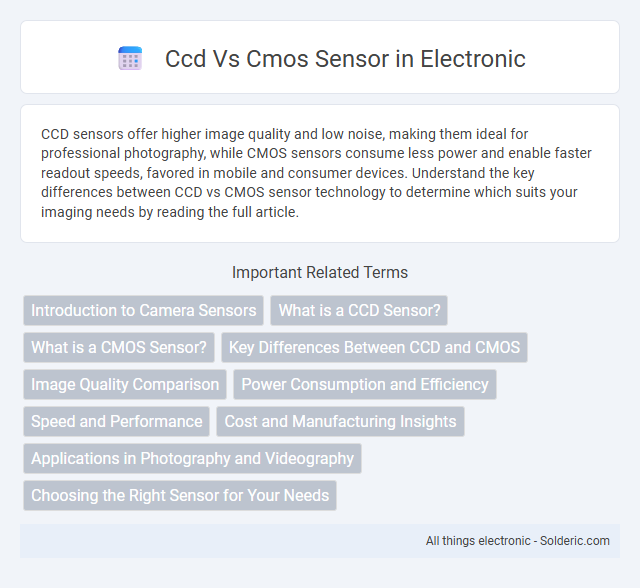CCD sensors offer higher image quality and low noise, making them ideal for professional photography, while CMOS sensors consume less power and enable faster readout speeds, favored in mobile and consumer devices. Understand the key differences between CCD vs CMOS sensor technology to determine which suits your imaging needs by reading the full article.
Comparison Table
| Feature | CCD Sensor | CMOS Sensor |
|---|---|---|
| Technology | Charge-Coupled Device | Complementary Metal-Oxide-Semiconductor |
| Image Quality | High quality, low noise | Good quality, higher noise than CCD |
| Power Consumption | High power usage | Low power usage |
| Speed | Slower readout speed | Faster readout speed |
| Cost | Expensive to manufacture | Cost-effective, cheaper |
| Sensitivity | Higher sensitivity in low light | Lower sensitivity in low light |
| Usage | Professional photography, scientific imaging | Consumer electronics, smartphones, webcams |
| Integration | Separate components, harder to integrate | On-chip integration with additional circuitry |
Introduction to Camera Sensors
CCD sensors offer high image quality and low noise, making them ideal for professional photography and scientific imaging. CMOS sensors provide faster readout speeds, lower power consumption, and better integration with modern electronics, which suits consumer cameras and mobile devices. Understanding your needs helps determine whether a CCD or CMOS sensor will optimize your camera's performance.
What is a CCD Sensor?
A CCD sensor, or Charge-Coupled Device, is an image sensor used in digital cameras and imaging devices to convert light into electronic signals with high image quality and low noise. It captures light through a grid of photodiodes and transfers the charge across the chip to be processed, making it ideal for applications requiring precise and detailed imaging like professional photography and scientific equipment. Understanding what a CCD sensor offers can help you determine the best sensor type for your imaging needs.
What is a CMOS Sensor?
A CMOS sensor, or Complementary Metal-Oxide-Semiconductor sensor, is a type of image sensor widely used in digital cameras and smartphones for converting light into electronic signals. It integrates photodiodes and amplifiers on a single chip, enabling faster processing speeds and lower power consumption compared to CCD sensors. CMOS sensors offer advantages such as improved noise reduction, real-time image processing, and cost-effective manufacturing, making them ideal for high-resolution and high-speed imaging applications.
Key Differences Between CCD and CMOS
CCD sensors capture images by transferring charge across the chip and reading it at one corner, which results in lower noise and higher image quality but with greater power consumption. CMOS sensors integrate amplifiers and noise-correction circuits at each pixel, enabling faster readout speeds, lower power usage, and cost-effective production. Your choice between CCD and CMOS depends on the importance of image quality versus speed, power efficiency, and budget constraints.
Image Quality Comparison
CCD sensors generally provide higher image quality with better light sensitivity, reduced noise, and greater dynamic range compared to CMOS sensors. CMOS sensors have improved significantly, offering faster readout speeds and lower power consumption, but may still exhibit more noise in low-light conditions. Understanding these differences helps you choose the optimal sensor for your photography needs, balancing image quality against performance and cost factors.
Power Consumption and Efficiency
CMOS sensors consume significantly less power than CCD sensors, making them more energy-efficient for prolonged use in battery-operated devices. With integrated circuitry, CMOS sensors process images directly on the chip, reducing overall power requirements and heat generation. Your choice of sensor affects device longevity and performance, especially in portable electronics where power consumption is critical.
Speed and Performance
CMOS sensors excel in speed and performance due to their ability to read data from multiple pixels simultaneously, resulting in faster image capture and reduced rolling shutter effects. CCD sensors, while traditionally offering high image quality, have slower readout speeds that can limit performance in fast-action photography. Your choice between CCD and CMOS will impact the speed of image processing and the ability to capture high-frame-rate sequences effectively.
Cost and Manufacturing Insights
CMOS sensors generally have lower manufacturing costs compared to CCD sensors due to simpler fabrication processes and compatibility with standard semiconductor production techniques. CCD sensors involve more complex manufacturing steps, resulting in higher costs, which impacts their use in budget-sensitive applications. Your choice between CCD and CMOS may hinge on balancing sensor performance needs against cost efficiencies.
Applications in Photography and Videography
CCD sensors excel in professional photography and videography due to their superior image quality, low noise, and high light sensitivity, making them ideal for studio shoots, scientific imaging, and high-end video production. CMOS sensors offer faster processing speeds, lower power consumption, and greater integration capabilities, which suits them well for consumer cameras, smartphones, and real-time video applications. Your choice depends on whether image fidelity or speed and efficiency is more critical for your specific photography or videography needs.
Choosing the Right Sensor for Your Needs
CCD sensors offer superior image quality and low noise, making them ideal for professional photography and scientific applications where precision is critical. CMOS sensors provide faster readout speeds, lower power consumption, and cost-effectiveness, suitable for smartphones, webcams, and real-time video recording. Selecting the right sensor depends on balancing image quality requirements with budget and application-specific needs.
ccd vs cmos sensor Infographic

 solderic.com
solderic.com